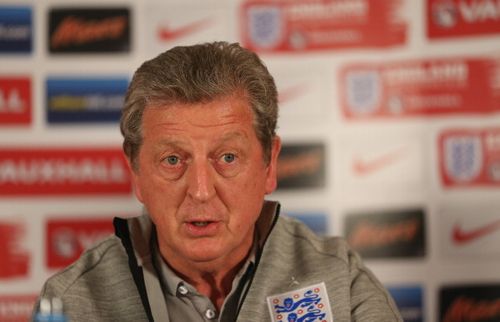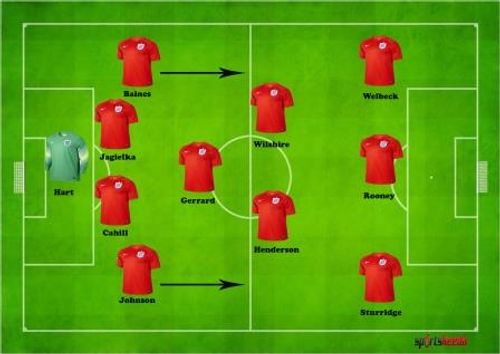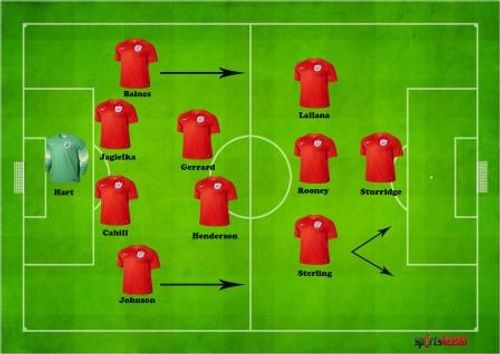
England: Team Preview – 2014 FIFA World Cup

The England National Football Team
It is time for yet another FIFA World Cup, and not surprisingly there is a lot of focus on the English national team. Despite boasting of the most lucrative football league in the world, the English Football Association and the clubs are often criticized for not promoting home-grown talent and giving preference to foreign players in order to rake in more money and get instant success in club football.
The famed “Golden Generation” of the Three Lions have flattered to deceive in the recent World Cups, and only a few of them have managed to get a spot in the squad which will go to Brazil. Unlike the hysteria and excitement that used to be persist in the previous editions, there is a sense of more balanced expectations this time among the supporters from the youthful team selected by Roy Hodgson.
Road to World Cup
England qualified for the 2014 FIFA World Cup by winning the UEFA qualifying Group H which also comprised of Ukraine, Montenegro, Moldova, Poland and San Marino. England enjoyed an unbeaten campaign which saw 6 wins and 4 draws, as they finished 1 point ahead of second placed Ukraine.
After beginning the campaign with a 5-0 win away at Moldova, England had a brief hiccup with a disappointing 1-1 draw at home against Ukraine. Wins against San Marino gave some momentum to the team’s quest for a spot in the World Cup, but draws at Poland and Montenegro meant it wasn’t smooth sailing. But that started a run of 10 points from the last 4 games which clinched the group, by virtue of which they got qualified for the World Cup.
Wayne Rooney was the team’s leading scorer in the qualifying campaign with 7 goals, while Frank Lampard and Danny Welbeck scored 4 goals each.
Squad
Liverpool’s excellent form in the Premier League which was driven by their English players meant that the club has the maximum representation in the England squad with Steven Gerrard, Jordan Henderson, Daniel Sturridge, Raheem Sterling and Glen Johnson all expected to play a vital role in the team’s fortunes at the World Cup. Youngster Jon Flanagan finds a place among the reserves.
By selecting Luke Shaw over Ashley Cole for the reserve left-back spot, Hodgson has shown his preference for youth and rewarded many youngsters for their impressive show in the Premier League. Everton’s Ross Barkley finds a spot in the 23-man squad as well, as do Shaw’s Southampton teammates Adam Lallana and Rickie Lambert.
Wayne Rooney will be expected to lead the attack and the striker will be keen to put on a good show after below-par performances in the previous World Cups. Frank Lampard is unlikely to be a regular starter for the team, but his vast experience will add value to the youthful squad and Hodgson will expect him to mentor the youngsters.
Goalkeepers: Fraser Forster (Celtic), Ben Foster (West Bromwich Albion), Joe Hart (Manchester City).
Defenders: Leighton Baines (Everton), Gary Cahill (Chelsea), Phil Jagielka (Everton), Glen Johnson (Liverpool), Phil Jones (Manchester United), Luke Shaw (Southampton), Chris Smalling (Manchester United).
Midfielders: Ross Barkley (Everton), Steven Gerrard (Liverpool), Jordan Henderson (Liverpool), Adam Lallana (Southampton), Frank Lampard (Chelsea), James Milner (Manchester City), Alex Oxlade-Chamberlain (Arsenal), Raheem Sterling (Liverpool), Jack Wilshere (Arsenal).
Forwards: Rickie Lambert (Southampton), Wayne Rooney (Manchester United), Daniel Sturridge (Liverpool), Danny Welbeck (Manchester United).
Standby: John Ruddy (Norwich City), Jon Flanagan (Liverpool), John Stones (Everton), Michael Carrick (Manchester United), Tom Cleverley (Manchester United), Andy Carroll (West Ham United), Jermain Defoe (Toronto FC).
Coach

Widely travelled and vastly experienced, England manager Roy Hodgson has managed 16 different teams across 8 countries. He guided the Swiss national team to the Round of 16 in the 1994 World Cup and later managed the Finnish national side and took them to 33rd place in the FIFA rankings – their highest ever.
Hodgson has won silverware in the Swedish and Danish leagues, and took his Inter Milan side to the final of the UEFA Cup. He later guided Fulham to the final of the revamped Europa League. An ill-fated spell at Liverpool, which coincided with the club’s ownership battles, remains a blot on Hodgson’s CV, though he later redeemed himself in the same season at West Bromwich Albion with an impressive run of form, which later helped him bag the role of the England national team manager.
With Fabio Capello’s resignation shortly before Euro 2012, Hodgson was given an uneviable task of leading the English side into the tournament. But Hodgson came out of the tournament with credit despite having very little preparation time as his team topped their group in the group stages, before bowing out of the tournament in the quarterfinals to the eventual runners-up Italy.
The position of the English national team manager is considered to be the pinnacle for English coaches, and after guiding the team to a successful qualification into the 2014 World Cup, Hodgson will be keen to enhance his credentials with a good show from his side in the tournament.
Best Starting XI
(4-3-3 Formation)
Goalkeeper: Joe Hart
Defenders: Glen Johnson, Gary Cahill, Phil Jagielka, Leighton Baines
Midfielders: Jordan Henderson, Steven Gerrard, Jack Wilshire
Forwards: Danny Welbeck, Wayne Rooney, Daniel Sturridge
Formation and Tactics
Roy Hodgson has admitted that he is unsure of what the best formation and tactics for the team will be. For England to succeed, it will be essential that Wayne Rooney and Daniel Sturridge combine well, and that Steven Gerrard controls the midfield from the quarter-back position in which he excelled for Liverpool in the 2013-14 season.
Gary Cahill and Phil Jagielka will form the first-choice central defensive partnership and along with goalkeeper Joe Hart and defensive support from Gerrard, they will look to ensure clean sheets for the team.
Leighton Baines and Glen Johnson will be expected to play the role of flying full-backs who would look to attack at every possible opening, and at the same time quickly track back to keep the opposition’s wingers in check.
Raheem Sterling and Ross Barkley will be eager to justify their inclusion in the squad despite their young age whenever they are given a chance, and the two can be expected to play a role for the team at some stage during the World Cup.
4-3-3 Formation

The implementation of this formation will depend largely on the fitness of Jack Wilshire who hasn’t started a game since fracturing his foot in the friendly against Denmark in March this year. Henderson and Wilshire will look to control the midfield with support from the passing range of Steven Gerrard (who will also be expected to track back to support the defence when the full-backs enter the opposition half).
The strike-force is likely to be led by Wayne Rooney, who will be supported by Daniel Sturridge (who has had an excellent season at Liverpool) and Danny Welbeck (who seems to have got Hodgson’s confidence with a good haul of goals for England while playing under him).
4-2-3-1 Formation

The 4-2-3-1 formation will look to maximize the impact of Adam Lallana and Raheem Sterling, both of whom were extremely impressive for their clubs in the 2013-14 season, with both looking to attack and create goal-scoring chances. Rooney and Sturridge will look to link up and interchange positions in attack.
History at the World Cup

England first participated in the FIFA World Cup in 1950 and were eliminated in the first round itself. The country hosted the event in 1966, and won the trophy, which makes it one among eight teams to have ever won the World Cup. The team, managed by Alf Ramsey and captained by Bobby Moore, beat West Germany 4-2 after extra-time in the final at Wembley and received the Jules Rimet Trophy from Queen Elizabeth II. Geoff Hurst was the standout player of the final as he scored a fine hat-trick, which included two extra-time goals.
Ramsey, a member of the team that competed in 1950 World Cup, was appointed as the team’s manager in 1963 with a view to bring contemporary practices to the national side. He shifted the team’s formation from 4-2-4 to a 4-4-2 system which got his side the nickname of “Wingless Wonders”. The two Bobbys – defender Moore and midfielder Charlton were the key players in the side.
However, the record of the team has been rather average since the win in 1966, and except for a semi-final appearance in the 1990 World Cup in Italy, the team has never managed to live up to the expectations.
Since the disappointment of missing out on qualifying for the 1994 World Cup, England have been a regular feature at the following World Cups, though the team has always failed to live up to the pre-tournament expectations and their star players have seldom played to their potential.
| YEAR | RESULT |
| 1930 | Did Not Participate |
| 1934 | Did Not Participate |
| 1938 | Did Not Participate |
| 1950 | Group stage |
| 1954 | Quarterfinals |
| 1958 | Group stage |
| 1962 | Quarterfinals |
| 1966 | Winners |
| 1970 | Quarterfinals |
| 1974 | Did Not Qualify |
| 1978 | Did Not Qualify |
| 1982 | Group stage 2 |
| 1986 | Quarterfinals |
| 1990 | Semifinals |
| 1994 | Did Not Qualify |
| 1998 | Round of 16 |
| 2002 | Quarterfinals |
| 2006 | Quarterfinals |
| 2010 | Round of 16 |
Predictions
England find themselves along with former champions Italy and Uruguay, and Costa Rica in a tough Group D which is touted by many as the “Group of Death”. Not many are giving England much of a chance to progress beyond the group stage, but the absence of the weight of expectations might just prove to be a blessing-in-disguise for the Steven Gerrard led side.
If the team performs to its potential, there is no reason why they cannot reach the knockout stages. The injury to Luis Suarez could be a big blow to Uruguay, and England & Italy can be expected to progress from the Group of Death to the Round of 16.
Prediction: Exit for England in the Quarterfinals inevitably on penalties.
To see other Team Previews : 2014 FIFA World Cup Team Previews